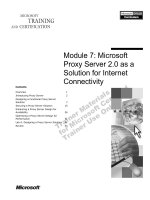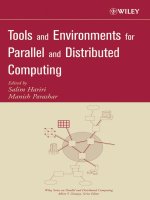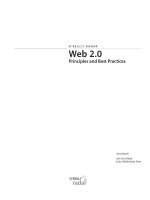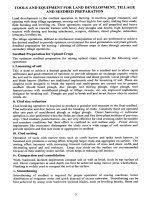Free telecollaboration 2.0 tools and activities for enhancing intercultural communicative competence
Bạn đang xem bản rút gọn của tài liệu. Xem và tải ngay bản đầy đủ của tài liệu tại đây (1.92 MB, 137 trang )
Eastern Michigan University
DigitalCommons@EMU
Master's eses and Doctoral Dissertations
Master's eses, and Doctoral Dissertations, and
Graduate Capstone Projects
8-28-2012
Free Telecollaboration 2.0 Tools and Activities for
Enhancing Intercultural Communicative
Competence
Khoi Nguyen i Bui
Follow this and additional works at: hp://commons.emich.edu/theses
is Open Access esis is brought to you for free and open access by the Master's eses, and Doctoral Dissertations, and Graduate Capstone Projects
at DigitalCommons@EMU. It has been accepted for inclusion in Master's eses and Doctoral Dissertations by an authorized administrator of
DigitalCommons@EMU. For more information, please contact
Recommended Citation
Bui, Khoi Nguyen i, "Free Telecollaboration 2.0 Tools and Activities for Enhancing Intercultural Communicative Competence"
(2012). Master's eses and Doctoral Dissertations. Paper 440.
Free Telecollaboration 2.0 Tools and Activities for Enhancing
Intercultural Communicative Competence
by
Bui Thi Khoi Nguyen
Thesis
Submitted to the Department of World Languages
Eastern Michigan University
in partial fulfillment of the requirements
for the degree of
Master of Arts
in
Teaching English to Speakers of Other Languages (TESOL)
Thesis Committee:
Elisabeth Morgan, Ph.D., Chair
Joe Bishop, Ph.D.
James Perren, Ed.D.
August 28, 2012
Ypsilanti, Michigan
ii
Dedication
I lovingly dedicate this thesis to my beloved daughter, Tran Anh Minh Khoi, for her
endless love and unobtrusive encouragement during her mom’s study and completion of
this thesis manuscript.
iii
Acknowledgments
First and foremost, I would like to express my most sincere and deepest gratitude
to my supervisor and promoter, Dr. Elisabeth Morgan, for her insightful advice, wisdom,
and professional guidance that particularly shaped my thesis research. I am honored to
have been accepted as her thesis student in the MA TESOL program of the Department
of World Languages at Eastern Michigan University. As a teacher of my TESOL classes,
an academic advisor of my master's program, and my thesis mentor, Dr. Morgan is my
strongest advocate, who wisely and genuinely guided me through a long process of
completing this thesis study: from asking for the teachers’ permission to set up the online
exchange, designing and delivering the informed consent form and the research
instruments, writing the research proposal, applying for University Human Subject
Research Committee approval, and collecting and analyzing data to revising my thesis
manuscript. She gave me the fastest and most thoughtful feedback on my thesis chapters
and was always there to lead me through difficulties although her working schedule was
very tight. Indeed, my professional development has been growing significantly with her
precious guidance and continuous motivation. I will never forget the proverb she sent to
comfort me during my heavy-hearted moment: “If all else fails, lower your standards.”
Without her great support, my online exchange project would not have been
accomplished and my thesis manuscript would not have been completed. I cannot
imagine a better thesis advisor than Dr. Morgan.
In addition, I am extremely grateful for the great input and guidance from the
other thesis committee members, Dr. Joe Bishop and Dr. James Perren. Thanks to Dr.
Bishop’s expert advice on my research design, research instruments and data analysis, the
iv
knowledge and the valuable books obtained from his Qualitative/Interpretive Qualitative
class, I have gone through this journey quite smoothly. I acknowledge Dr. Perren’s
permission in citing his published works and previous research information in my thesis
writing as well as his detailed comments on the content and technical issues of my thesis
proposal and manuscript.
I express my true appreciation to Dr. Vo Tong Xuan and Dr. Tran Xuan Thao, the
provost and vice provost, respectively, of Tan Tao University in Vietnam, for their
permission and great support of making the online exchange happen. Many heartfelt
thanks to Dr. Ngan Nguyen for her great support during my research at Tan Tao
University. My thankfulness is given to Mr. Nhon Dang, a close friend of my husband's
and mine, for connecting me to Dr. Ngan Nguyen and for his sincere comments and
prompt help during the online exchange. I honestly thank Ms. Trang Vo, my close
Vietnamese friend at Eastern Michigan University, for her encouragement of my
research, her unselfish friendship, and her help in transcribing the raw data of my
research interview with an EMU student.
My deep appreciation is extended to the participants of this study – the students of
the ESL class at Tan Tao University and those of the Second Language Acquisition class
at Eastern Michigan University. I am thankful for their willingness to participate, their
precious time to join the online activities, especially those who shared their experiences
in the interviews after the online exchange, which made this research study possible.
I owe my parents and my sisters my wholehearted appreciation for their
continuous mental support. Their endless love and shared experiences always help me see
beyond what sometimes looks like a challenging task and then accomplish it successfully.
v
I would never be who I am or could do what I am doing today without their love, support,
and trust. The online conversations with them have helped me shape my determination to
overcome all difficulties to reach the objectives of my thesis research. Although we are
not geographically close to each other, they are all always in my mind as strong
motivators.
My special love and dearest thanks come to my wonderful husband, Mr. Tran
Anh Thong, and my beloved daughter, Tran Anh Minh Khoi, for being spiritually side by
side with me though I was away from home. No words can best express my deep love
and gratitude to my husband for taking care of my lovely daughter well so that I could
concentrate on facilitating the online exchange and conducting my thesis research. Their
true love, patience, and spiritual support have strengthened my will to finish writing my
thesis within the shortest time that I have ever thought of. Though busy with many
research projects in Vietnam and preparing for his upcoming doctoral study in Australia,
my husband invested a lot of time in producing high quality transcripts for this research.
Being in the early years of cognitive thinking development, my cute daughter always
knows how to set my mind at rest for my study with her innocent words for inspiration.
The fact that she healthily grew up, played well, and studied hard made me mentally
stable for completing my thesis manuscript. I am deeply blessed to have them in my life
and always indebted for their generous sacrifice, encouragement, and persistent support
in my pursuit of this master's degree, my completion of this thesis research and in all
areas of life.
I thank all my dear friends, EMU professors, EMU classmates, Fulbright cohorts,
IFP (International Fellowship Program) students, and colleagues for lifting my spirits at
vi
each turning point of this overwhelming journey. Whether geographically near or far,
they have outweighed my stress from working on the thesis manuscript. Especially, I
could not have carried out this study without the financial support from the Fulbright
Program for Foreign Students sponsored by the U.S. Department of States and the grant
extension approval from the Institute of International Education. I count each of them as
my special blessings.
vii
Abstract
This study examines the effectiveness and relevance of some free
telecollaboration 2.0 tools and the IT-HELPS activities to the participants’ enhancement
of intercultural communicative competence (ICC) in reference to Byram’s (1997) ICC
definition and its five principles. In-depth qualitative data were collected from six semi-
structured interviews with students and teachers of the eight-week online intercultural
exchange between a Second Language Acquisition class at Eastern Michigan University
in the United States and an English as a Second Language class at Tan Tao University in
Vietnam. Despite the failed communication in some collaborative tasks due to some
deficiencies in motivating, facilitating, and managing the exchange activities, the study
results showed the informants’ positive changes of ICC and the Vietnamese students’
significant improvement of English language skills. New avenues and suggestions were
also discussed for further research into the benefits of using free telecollaboration 2.0
tools and activities for intercultural learning via online exchanges.
viii
List of Abbreviations
CALL: Computer Assisted Language Learning
CMC: Computer Mediated Communication
EFL: English as a Foreign Language
ESL: English as a Second Language
EMU: Eastern Michigan University
ICC: Intercultural Communicative Competence
ICT: Information and Communication Technology
IT-HELPS: Seven suggested topics for the exchange activities: Identity, Taboos and
Stereotypes, Holidays, Education and entertainment, Language, People and
places, and Social issues.
L1: First Language
L2: Second Language
LMS: Learning Management System
NSs: Native Speakers
NNSs: Non-native Speakers
TOEFL: Test of English as a Foreign Language
TTU: Tan Tao University
ix
TABLE OF CONTENTS
Dedication ii
Acknowledgements iii
Abstract vii
Abbreviations viii
Chapter 1: Introduction 1
Chapter 2: Literature Review 11
Chapter 3: Methodology 31
Chapter 4: Findings and Discussion 48
Chapter 5: Conclusions……………………………………………………….… ……. 93
References ………………………….…101
Appendix A: Timeline of the IT-HELPS Exchange………………………………… 117
Appendix B: University Human Subject Review Committee Approval Letter …….…119
Appendix C: Thesis Proposal Approval Form ……………………………… ….…120
Appendix D: Background Information Questionnaire ……………………………… 121
Appendix E: Semi-Structured Interview Questions for Students …………………… 123
Appendix F: Semi-structured Interview Questions for Teachers ………………… …124
Appendix G: Informed Consent Agreement: ……………………………………….…125
x
LIST OF TABLES
Table Page
1 Background Information of the Participants………………………………… 34
2 Participants’ Ability in Using the Free Technologies of the IT-HELPS
Exchange …………………………………………… ……………………….34
xi
LIST OF FIGURES
Figure Page
1 The adaptation of Kachru’s (1985) circles of Englishes……………… 4
2 The language and culture teaching process (Byram, 1990, p. 20)…… 9
3 The design of the online intercultural exchange……………… …… 10
4 Factors in intercultural communication (Byram, 1997, p.34)……… 13
5 The homepage of the IT-HELPS website……………………….…… 42
Chapter 1: Introduction
Problem Statement and Background
In today’s global context, with the rapid developments in information and
communication technologies (ICT), the thirst for knowledge access and mutual
understanding transcends the limitation of geographical boundaries and the different
educational and administrative systems between the superpowers and less influential
countries. In education, this pressing demand, in turn, draws on an establishment of a
networking system that can help people share knowledge and information as well as
deliver different types of educational services. Recent developments in ICT have
heightened the need for using computers and the Internet in today's classes in general and
in language classes in particular. Information overload, rapid changes in communication
technology, globalization, and new knowledge-acquisition modalities make a computer-
based learning environment more important than ever. Referring to the chaos of
information and texts on the Internet, Kol and Schcolnik (2000) state, “The profession is
witnessing increased availability of academic and professional texts (both books and
articles) on the Internet” (p. 67). Understandably, rapid evolution of communication
technologies has changed the instruction and use of a target language, enabling new forms
of interaction and ways to participate in academic communities (Kern, 2006). Likewise,
James (1996) points out, “Educational technology is often presented as a potential means
for making the students’ learning experiences richer and the teacher’s job easier” (p. 20).
With more online opportunities, learners can surely reach out to the world and hence
create better chances for language and culture exchanging and learning. According to
Warschauer (2000), globalization and the increasing advent of new information
2
technologies further the spread of English and change English language in use. In other
words, technology contributes to transforming or at least to changing the teaching and
learning methods, and eventually empowering learners and teachers with more flexibility.
Along the same line, technological tools should be used in a context such as the one in
Vietnam because technology can “offer students a venue for additional interesting and
engaging activities, ensure student-centeredness and autonomy as well as interaction and
connectivity” (Pop, 2010, p. 1186).
To fill the gap in using technologies for teaching and learning in general and in
language education in particular, the administrators of the education sectors in countries
where English is a foreign language (EFL) have called for practical applications of
technology in curriculum reform and pedagogical innovation. In Vietnam, for example,
the Ministry of Education and Training (MOET) invested significantly in computers in
schools and encouraged teachers to use computers in their teaching. The MOET created
the Directive on Promoting Teaching, Training and Applying ICT in Education – Period
2008-2012 (MOET, 2008) for all schools across the country to improve the education
system in general and the teaching of EFL in particular through the application of
computer technology in education between 2008 and 2012. Learning Management
Systems (LMS) are also available at higher education institutions. However, questions
have been raised about the appropriate use of technologies in language education because
it is generally limited to teachers’ use of PowerPoint presentations to partly replace chalk
and blackboards in language classrooms. Unfortunately, not many language educators can
fully explore the available technological tools to connect different language learners
across boundaries due to the high cost of educational software and technologies, the
3
moderate technological skills of the users, and the lack of task management skills by
teachers (Perren, 2001). There are many contexts for the best e-lessons using MS
PowerPoint, but not many language teachers know how to explore the free technologies
online, especially to connect learners across countries.
In these EFL countries, it is obvious that the classroom is the only environment for
English language acquisition and practice; thus the fact that the teaching and learning of
EFL has become extremely significant resulted in the mushrooming and extensive
proliferation of many English-language classes. Nevertheless, the quantity of English
classes and importance of EFL education do not guarantee a compatible level of teaching
quality because of some existing problems. For instance, in Vietnam, one of these
challenges is how to teach learners to use English effectively in communication with other
people in real-world situations (Le, 1999). Many institutions and foreign language centers
are willing to pay high salaries to recruit native speakers of English for teaching positions,
even those without proper education or teaching training in English for speakers of other
languages (ESOL). In this context, however, cultural teaching in English language classes
is ignored, and intercultural exchange programs are mainly used as study-abroad tours,
which reach only wealthy learners or high-paid private foreign language centers.
With the aforementioned issues, simply providing access to ICT will not
completely make educational systems better, but exploring their full potential in online
exchanges for specific situations and educational goals may. In fact, it is urgent to focus
on the meaningful integration of inexpensive ICT into intercultural exchanges in order to
fill the gaps of learners’ different ethnic backgrounds, socio-economic statuses, ages,
educational backgrounds and geographical locations. Many intercultural exchanges have
4
tried to link the native speakers of English (NS) and the non-native speakers of English
(NNS) using study-abroad tours and online tools; however, free Web 2.0 tools which have
many dominant features to Web 1.0 have not been explored effectively, especially in
developing countries. Therefore, this research study focused on examining the possibility
of using free telecollaboration 2.0 tools and relevant intercultural exchange activities to
effectively enhance language learners’ intercultural communicative competence. Figure 1
can best illustrate this purpose in using telecollaboration 2.0 tools to connect NS and NNS
in online exchange:
Figure 1. The adaptation of Kachru’s (1985) circles of Englishes
Justification and Significance
The importance of conducting this research is manifold. First, this study is
specifically beneficial for language teachers and learners at Tan Tao University in
Vietnam as well as at Eastern Michigan University. Actually, the results of this research
can help teachers create more interesting class activities and authentic communication
with speakers from other cultures. The findings from this research are helpful for all
English language teachers because all of the exchange activities and materials are based
on the TESOL technology standards for language learners and teachers (Healy et al., n.d),
5
most notably Goal 2, which focuses on language learners’ use of technology in socially
and culturally appropriate, legal, and ethical ways. More specifically, this goal has two
standards to follow: (1) Language learners have the ability to understand different
communication conventions across cultures, communities, and contexts, and (2) Language
learners become respectful for others in using information personally and publicly.
Therefore, if the application of these activities in this research shows good results, then the
student outcomes are met. In fact, if these activities can be used as originally designed, the
participants implicitly and easily meet these standards. In addition, participants have a
good chance to learn the target language and increase their intercultural communicative
competence with less pressure in a virtual world with free hi-tech support. Students can
learn another culture and language authentically for free without being afraid of losing
face. Consequently, the study paves a smooth route to better serve the broader population
of EFL learners in Vietnam with effective communicative English and intercultural
learning. The research results may also give multiple applications and a vast array of self-
improvement opportunities for better English learning in other developing countries in
South East Asia with situations similar to those in Vietnam where a virtually and
culturally enriched environment to develop the language and culture knowledge rarely
exists for free.
Second, this research is unique in Vietnam in the field of online intercultural
exchanges and may lead to a trend in using a culturally inclusive curriculum for language
learning. Some exchange programs have been developed in Vietnam, but no previous
program was done online with many activities that could be embedded into the existing
ESL/ EFL curricula of the participants to enhance ICC. Therefore, examining the
6
relevance and effectiveness of the designed activities and the chosen technologies in this
research may open a new door to curriculum reform for better English language learning
in Vietnam. Especially since most of the U.S. participants in the study from the Second
Language Acquisition class at Eastern Michigan University will become language
teachers, this project is very beneficial for them. Indeed, these participants learned first-
hand about the advantages and disadvantages of online materials and tools in English
language education. They were able to learn how to effectively communicate with
learners of English as a second language, and this is of great benefit for their future
English language teaching.
Moreover, despite the increasing popularity of research on intercultural exchange
programs in the world and the fact that network-based learning and telecollaboration have
been in use for a long time, very few studies have focused on evaluating the cultural
learning outcomes in the digital world (Kern, 2002). Thus, this study will contribute some
evidence to enrich this field of study.
Finally, it is relatively unclear how online exchanges can actually contribute to
intercultural learning (O’Dowd, 2007). Therefore, this study serves as another stepping
stone for further research into the field of telecollaboration 2.0. Indeed, this research
provides more evidence on the possibility of enhancing intercultural communicative
competence through online exchange programs for free, especially in developing
countries like Vietnam.
7
Purpose of the Study
In this online intercultural exchange program between ESL students at Tan Tao
University in Vietnam and students in a Second Language Acquisition class at Eastern
Michigan University, the researcher targeted the following two objectives:
Objective 1 – Determining whether the participants have enhanced their
intercultural communicative competence in this online intercultural exchange.
Objective 2 – Examining the effectiveness and relevance of the selected free
technological tools and the IT-HELPS activities in enhancing the participants’
intercultural communicative competence in the asynchronous and synchronous
exchanges.
Research Question
How relevant and effective are the IT-HELPS activities and the free telecollaboration 2.0
tools in enhancing students’ intercultural communicative competence in the online
intercultural exchanges between students of Tan Tao University and Eastern Michigan
University?
Theoretical Framework
The notion of “Intercultural Communicative Competence” (ICC) is used with
various meanings and may be referred to under other labels. In the general literature, the
two terms “intercultural communicative competence” and “intercultural competence” are
often used interchangeably. However, a thorough theoretical grounding for this research
was based on Byram’s (1997) definition of “Intercultural Communicative Competence” as
the ability to establish and maintain relations with members of other cultures in a foreign
language.
8
This model of ICC, which consists of the five principles of the two skills of
interpreting/relating and discovery/interaction, knowledge, attitudes, and critical cultural
awareness, is considered to be the most suitable starting point for developing a framework
for the various goals of telecollaboration even though it was not developed for
telecollaboration contexts (Helm & Guth, 2010); therefore, it was used in this study with
the goal:
To develop learners as intercultural speakers or mediators who are able to engage
with complexity and multiple identities and to avoid the stereotyping which
accompanies perceiving someone through a single identity. It is based on
perceiving the interlocutor as an individual whose qualities are to be discovered
rather than as a representative of an externally ascribed identity. (Byram,
Gribkova & Starkey, 2002, p. 9)
It is believed that the learner will develop his/her awareness through explicit
recognition and real experience of one or more interdependent factors that are overtly
inclusive in the class activities. Figure 2 visualizes this important interrelationship among
learning, awareness, and experience in the language and culture teaching process that this
study aimed to investigate.
9
Figure 2. The language and culture teaching process (Byram, 1990, p. 20)
Based on the above framework demonstrating the relationship between language and
culture, the IT-HELPS activities were designed to purposefully develop learners’
intercultural communicative competence (ICC) in the online intercultural exchange. The
IT-HELPS activities used both asynchronous and synchronous telecollaboration 2.0 tools
to facilitate the discussions, collaborative projects, video/movie/article sharing, video
making, language learning, and video conferencing of seven topics abbreviated under the
IT-HELPS:Identity, Taboos and Stereotypes, Holidays, Education and Entertainment,
Languages, People and Places, and Social Issues. These activities are theoretically based
on the five principles of Byram’s (1997) ICC model: Knowledge, Skills of Interpreting
and Relating, Skills of Discovery and Skills of Interaction, Attitude, and Critical Cultural
Awareness. It was believed that the design of these culturally inclusive activities that
explicitly focused on developing these five principles of Byram’s ICC model could
eventually enhance the participants’ ICC. More detailed descriptions of these activities are
presented later in Chapter Three, but the design can be visualized as follows:
10
Figure 3. The design of the online intercultural exchange
Tele-collaboration 2.0
Classroom activities
11
Chapter 2: Literature Review
Intercultural Communicative Competence (ICC)
Definition of intercultural communicative competence. The notion of
intercultural communicative competence (ICC) is used with various meanings and may be
referred to under other labels. For instance, several terms used interchangeably are global
competence, international competence, multicultural competence, intercultural maturity,
communicative competence, cross-cultural competence, cultural competence, intercultural
interaction, transcultural communication, and intercultural cooperation (Fatini, 2006).
In the general literature of intercultural learning, the two terms “intercultural
communicative competence” and “intercultural competence” are often used as synonyms.
However, Byram (1997) and other authors refer to intercultural competence as the ability
to establish and maintain relations with members of other cultures, but it is not necessarily
linked to foreign language competence, while intercultural communicative competence
implies that the learner can do this in a foreign language (Helm & Guth, 2010).
The definition of ICC is neither clear nor comparable internationally (Vogt, 2006).
Many language-teaching professionals commonly view intercultural communicative
competence (ICC) as an extension of communicative competence. For example, Beneke
(2000) explained:
Intercultural communication in the wider sense of the word involves the use of
significantly different linguistic codes and contact between people holding
significantly different sets of values and models of the world … Intercultural
12
competence is to a large extent the ability to cope with one’s own cultural
background in interaction with others. (pp. 108-109)
However, Fantini (2000) analyzed ICC in a more complex way. He described ICC
as “complex abilities that are required to perform effectively and appropriately when
interacting with others who are linguistically and culturally different from oneself” (p. 1).
“Effective” usually reflects one’s own view of one’s performance in the outsider’s view of
the host culture, and “appropriate” relates to how one’s performance is perceived by one’s
hosts. He also discussed the multiple elements of ICC such as a variety of traits and
characteristics (i.e., flexibility, humor, patience, openness, interest, curiosity, empathy,
tolerance for ambiguity, and suspending judgment, among others); three areas or domains
(the ability to establish and maintain relationships, the ability to communicate with
minimal loss or distortion, the ability to collaborate in order to accomplish something of
mutual interest or need); four dimensions (knowledge, [positive] attitudes/affect, skills,
and awareness); proficiency in the host language; and varying levels of attainment
throughout a longitudinal and developmental process. Slightly different, Byram’s (1997)
model of intercultural communicative competence requires certain attitudes, knowledge,
and skills in addition to linguistic, sociolinguistic, and discourse competence. The
attitudes include curiosity and openness as well as readiness to see other cultures and the
speaker’s own without being judgmental. The required knowledge is “of social groups and
their products and practices in one’s own and in one’s interlocutor’s country, and of the
general processes of societal and individual interaction” (p. 51). Finally, the skills include
those of interpreting and relating, discovery, and interaction, in addition to critical cultural
awareness/political education. Because of its usefulness and clarity, Byram’s (1997)
13
model of intercultural communicative competence with its five principles of skills of
interpreting and relating, skills of discovery and interaction, knowledge, attitudes, and
critical cultural awareness are used in this study to specifically refer to “the ability to
communicate effectively in cross-cultural situations and to relate appropriately in a variety
of cultural contexts” (Bennett & Bennett, 2004, p. 149). The five principles can be
visually understood as shown in Figure 4:
Skills
interpret and relate
(savoir comprendre)
Knowledge
of self and other;
of interaction;
individual and societal
(savoir être)
Education
political education
critical cultural awareness
(savoir s’engager)
Attitudes
relativising self
valuing other
(savoir être)
Skills
discover and/or interact
(savoir apprendre/faire)
Figure 4. Factors in intercultural communication (Byram, 1997, p.34)
The importance of enhancing intercultural communicative competence (ICC).
There are many reasons to develop intercultural communicative competence (ICC) in
language learners. First, having the ICC to sustain effective communication across
cultures can help learners “heighten the language learning experience” (Lomicka, 2006, p.
211) and motivate learning in authentic language communication. Second, empowering
language learners with ICC can improve their proficiency of the target language because
language and culture are inseparable. Even writers such as Guest (2002), who did not
believe in the purpose of direct teaching of culture, agrees that we tend to transmit the
values of English culture in teaching English. Valdes (1990) remarked that if culture is an
unavoidable part of language teaching, then “recognizing the culture lessons to be learned









